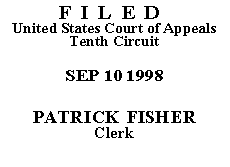|
AUDREY SPLAIN, Petitioner-Appellant, v. TOM NEWTON, Warden; ATTORNEY GENERAL FOR THE STATE OF NEW MEXICO, Respondents-Appellees. |
|

After examining the briefs and the appellate record, this three-judge panel has unanimously determined that oral argument would not be of material assistance in the determination of this appeal. See Fed. R. App. P. 34(a); 10th Cir. R. 34.1.9. The case is therefore ordered submitted without oral argument.
Audrey Splain seeks to appeal the district court's order dismissing her 28 U.S.C. § 2254 habeas corpus petition with prejudice. Because this court concludes that Splain has not made a substantial showing of the denial of her constitutional rights, we deny her a certificate of probable cause and dismiss the appeal.(1)
Splain was convicted of trafficking in cocaine in New Mexico state court in 1994. Splain exhausted her claims on direct appeal to the New Mexico Court of Appeals and filed this § 2254 petition in 1995. Splain raises the following three claims in support of her petition: (1) her Sixth Amendment rights were violated by the exclusion of African-Americans from the venire panel; (2) her due process rights were violated by the admission of a mass spectrometer analysis to prove the illegal material was cocaine; and (3) she was convicted on the basis of insufficient evidence in violation of the Due Process Clause.
In resolving Splain's claim regarding the venire panel, the district court noted that the African-American population within the relevant New Mexico district was between two and five percent and that the total size of the venire was forty-eight people. In light of the size of the venire and the African-American population, one or two African-Americans would have represented a fair cross-section of the community. With this background in mind, the district court concluded that Splain's claim failed because she could not show a systematic and deliberate exclusion of African-Americans from the venire. See United States v. Ruiz-Castro, 92 F.3d 1519, 1527 (10th Cir. 1996) (holding that to establish a prima facie case under the Sixth Amendment, a movant must show that the underrepresentation of a minority group is due to "systematic exclusion of the group in the jury-selection process"). Splain's claim was based solely on the absence of African-American's from her particular venire without reference to whether such a result was a statistical anomaly or a systematic practice. See Duran v. Missouri, 439 U.S. 357, 362 (1979) (movant stated prima facie case by demonstrating systematic exclusion of minority group over six month period); Taylor v. Missouri, 419 U.S. 522, 524 (1975) (same over one year period). Furthermore, the African-American population in the relevant area was small enough that the absence of any African-Americans from the venire was not statistically unlikely. Cf. Castaneda v. Partida, 430 U.S. 482, 486-87 (1977) (movant made prima facie case where Mexican-American population in county was approximately eighty percent while percentage of Mexican-Americans on grand jury panels was approximately thirty-nine percent over ten year period).
As to Splain's claims concerning the admission of the mass spectrometer tests, the district court noted that Splain's arguments related to the weight of the evidence rather than its admission and that the admission of the tests did not render her trial fundamentally unfair. See Maes v. Thomas, 46 F.3d 979, 987 (10th Cir. 1995) (holding that a federal court cannot grant habeas relief for state evidentiary rulings unless those rulings rendered the trial as a whole fundamentally unfair). Finally, the district court noted that Splain's claims regarding the sufficiency of the evidence boiled down to the claim that the sole witness against her at trial was not worthy of belief. As properly noted by the district court, in concluding whether evidence is constitutionally sufficient, a federal court "may neither weigh conflicting evidence nor consider the credibility of witnesses." United States v. Harrod, 981 F.2d 1171, 1174 (10th Cir. 1992).
This court has considered de novo Splain's appellate brief, the magistrate's report and recommendation, and the entire record on appeal. In light of that review, there can be no question that the district court's resolution of Splain's claims is not debatable among jurists, deserving of further proceedings, or subject to an alternate resolution. See Gallagher v. Hannigan, 24 F.3d 68, 68 (10th Cir.1994). Accordingly, Splain has not made a substantial showing of the denial of an important federal right and is not, therefore, entitled to a certificate of probable cause. The request for a certificate of probable cause is DENIED and this matter is DISMISSED.
ENTERED FOR THE COURT
Michael R. Murphy
Circuit Judge
*. This order and judgment is not binding precedent, except under the doctrines of law of the case, res judicata and collateral estoppel. The court generally disfavors the citation of orders and judgments; nevertheless, an order and judgment may be cited under the terms and conditions of 10th Cir. R. 36.3.
1.Because Splain filed her § 2254 petition in July of 1995, the Antiterrorism and Effective Death Penalty Act of 1996 ("AEDPA") does not apply. See Lindh v. Murphy, 117 S. Ct. 2059, 2063 (1997); United States v. Kunzman, 125 F.3d 1363, 1364 n.2 (10th Cir. 1997). This court, therefore, construes Splain's appeal as a request for a certificate of probable cause under the pre-AEDPA version of 28 U.S.C. § 2253. See Hernandez v. Starbuck, 69 F.3d 1089, 1090 n.1 (10th Cir. 1995).